Is Your IT Automation Allowing You to Achieve Pervasive Integration?
We recently interviewed D&H Distributing on their use of automation to integrate disparate applications, and how they mastered pervasive integration.

A recent Gartner research study, titled How to Achieve Digital Business Excellence by Mastering Pervasive Integration, highlights the need for interconnections between business processes, on-premise and cloud or hybrid environments, IoT components, IT systems, and more. If organizations want to stay on top of dynamic business demands and remain aggressive in their industry, it is imperative that they implement a pervasive integration strategy into their business. An IT automation solution can be just what an organization needs to master this. In a new Case Study, we investigated D&H Distributing, a leading technology distributor of IT and electronics, on their use of automation to integrate disparate applications. With the right solution, D&H overcame integration obstacles by connecting different applications and systems throughout their business.
According to Gartner research, one key challenge is the need for integration across different platforms, systems, and applications. This is one integration challenge that D&H faced with the IT automation tool they had been using. They found that their existing automation tool could not execute processes that they needed it to across certain platforms, applications, and technologies, such as Dynamics AX, for example. D&H needed a solution that provided a unified, integration-centered approach and allowed them to handle the mass amounts of data and the cross-platform processes they were facing. D&H needed a solution that would allow them to master pervasive integration, without requiring them to migrate old or build out new code to create these integrations. When looking for a new solution, Mike Everly, the Chief Information Officer for D&H explained that it was “critical that [they] manage costs while finding agile, scalable solutions that allow [them] to adapt to change.”
That year, things started to look up when the D&H team met ActiveBatch IT Automation at the Gartner Symposium ITxpo. D&H saw the value in ActiveBatch, and decided to bring it on board as their Enterprise IT Automation solution. By simplifying their integrations with applications like Microsoft Dynamics AX, System Center Operations Manager, SharePoint, Team Foundation Server, and IBM Cognos BI, DataStage, and VMware, ActiveBatch allowed D&H to simplify integrations across their entire organization.
These integrations, and more, allowed D&H to discover a wide range of beneficial opportunities that ActiveBatch provided them with. They discovered that they were easily able to manage dependencies, simplify the sharing of data between systems, and significantly reduce the amount of code they needed to write. Representatives from D&H agreed that ActiveBatch has saved them time, removed integration roadblocks, and improved their business services in not just IT processes, but many operational areas. Finding the right IT automation solution allowed them to achieve agility throughout their entire business.
A solution like ActiveBatch can allow organizations to master pervasive integration by giving them the ability to control their business and IT processes, disparate applications and technologies, and more, all from one place. Read the full free Case Study, and see what else D&H accomplished with automation, here:







